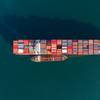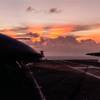Partnerships of Deep-Sea Methane Scavengers Revealed
The sea floor off the coast of , , is home to a diverse assemblage of microbes that scavenge methane from cold deep-sea vents. Researchers at the California Institute of Technology have developed a technique to directly capture these cells, lending insight into the diverse symbiotic partnerships that evolved among different species in an extreme environment.
The community's interconnected metabolism sheds light on how the anaerobic microbes, which consume nearly 80 percent of the methane leaked from marine sediments, limit oceanic emissions of this potent greenhouse gas.
Metagenomic analysis, in which the genetic material of all microorganisms swept from their homes in a sample is sequenced wholesale, yields a plenitude of general information. Annelie Pernthaler, a former Caltech postdoc who is now a research scientist at the Centre for Environmental Research in , and Orphan devised a technique to tease out individuals from the diverse microbial community of the deep-sea sediment. Their aim: to simplify the genomic sequencing to target only the organisms they were interested in.
They began with descents in the manned submersible , collecting cores of sea-floor sediment from areas where methane migrates from below. Back in the lab, the team used enzyme-tagged short DNA probes to specifically bind the ribosomal RNA in the methane-consuming microbes of the sediment. A second reaction used the enzyme to deposit fluorescent molecules within and around the cell, a method known as CARD-FISH, for "catalyzed reporter deposition fluorescence in situ hybridization."
The fluorescing cells and attached microorganisms were captured using microbeads that are both paramagnetic--a form of magnetism occurring only in the presence of an externally applied magnetic field--and coated with an antibody to the fluorescent molecule. This Caltech-patented technique, called "magneto-FISH," bypasses the need to grow the microorganisms in culture because it targets the fluorescing molecules around the cell instead of a specific molecule within the cell.
The cells separated by magneto-FISHing reveal who's partnered up with whom, and provides a fresh look at microbial symbiosis in nature, Orphan says. The main player near the methane vents is a methane-metabolizing member of the Archaea, a prokaryotic domain of life distinct from both bacteria and eukaryotes. Piggybacked on the archaeal cells are some members from among four different species of bacteria--three more than were previously known to be associated with these particular archaea--whose exact roles in the system can now be addressed.
The methane-vent partnership between archaea that consume methane and bacteria that reduce sulfate is believed to be a form of cometabolism or syntrophy, meaning "feeding together," where one species lives off the metabolic products of others. Using the information obtained from the metagenome of these partnerships, says Orphan, biologists can develop specific experiments to directly test the physiological and nutritional relationships between these organisms, as well as the ecological strategies used to successfully colonize deep-sea environments.
One example of such an experiment is highlighted in the group's study, published May 8 in the early online edition of the journal PNAS. The researchers discovered that the organisms possess genes for nitrogen fixation, a process that converts nitrogen gas into nourishing compounds like ammonia. "We were surprised to see these genes in the captured cells," says Anne Dekas, a geobiology graduate student at Caltech, "because we thought these organisms were relatively energy-starved, and nitrogen fixation takes a lot of energy."
Orphan and Dekas were able to show that the organisms are not just equipped for the task, they are actually carrying it out. "Showing nitrogen fixation is a great finding in itself," Dekas comments, "but it is also just one example of the hypothesis testing that can follow magneto-FISH coupled to metagenomic analysis."












